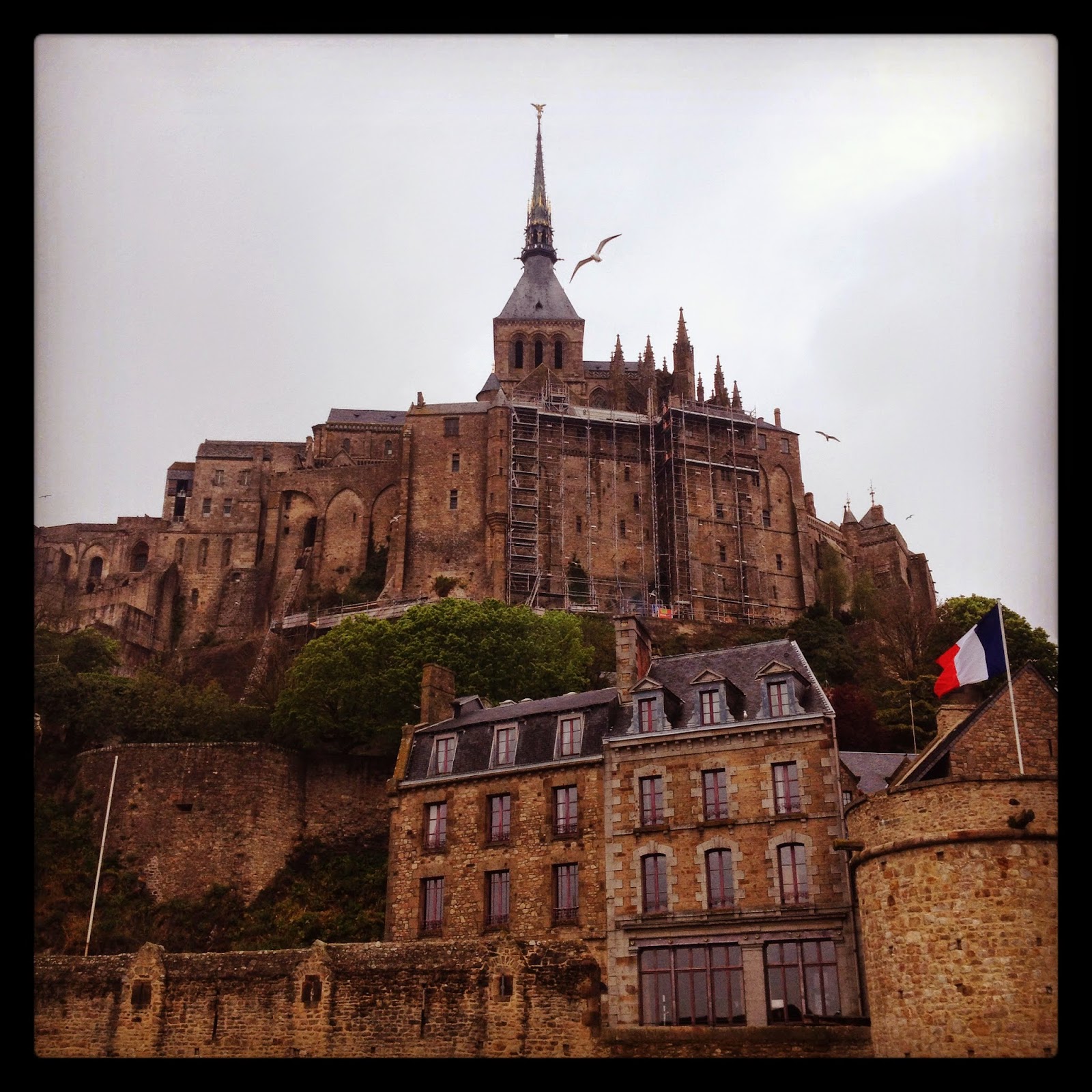Saturday my parents and I headed out with a guide to tour Normandy. I knew the day would be long and physically tiring but what I didn't expect was being so emotionally worn out.
Our guide, Geert, met us early Saturday and we headed to The American Cemetery of Normandy for the 9am opening. We were the first ones there and other than 1 or 2 other families by the end of our visit, we were the only ones. We were able to watch them raise the two American flags and really take in the cemetery. 9,387 soldiers are buried there and 307 of them are unidentified. The stark white crosses against the green grass seem to go on forever.
 |
| Normandy American Cemetery |
When you enter the cemetery you pass the memorial. A large bronze statue symbolizing "American Youth Rising from the Waves" faces the cemetery. If you walk behind the memorial, you enter the Garden of the Missing, which lists the 1,157 men that have never been found. A large majority of the men were from the 66th division, who's boat was torpedoed on Christmas eve. A few of the names have small rosettes engraved next to them, symbolizing that they have since been found.
 |
The American Cemetery, the reflective pool
an unknown soldier and the memorial |
The weather at the cemetery was perfect, it was clear skies, sunny and peaceful. Geert brought us to the grave of Theodore Mister, who was killed on June 13 and who's path we would be tracing.
We then headed to Omaha Beach, which was the deadliest assault of D-Day, with around a 90% casualty rate in the first hour. The men left England for Omaha on July 4th and were dropped 10 miles off shore to take the landing boats in the rest of the way. The soldiers had to land at low tide and farther out from the shore then expected. They had to wade through the water to the beach and sand dunes hidden below the water were unanticipated and deadly. If a soldier stepped off the sand dune he would drown due to the heavy equipment. Once the men made it to the shore they had to sprint across the beach for cover, passing a wide open area, where many were shot down. Many of the men listed on the wall of the Garden of the Missing are presumed to have been washed out to sea.
 |
| On Omaha Beach |
From there we headed inland tracing Mister's steps. We passed the Church of Trevieres located in the first town that many soldier's saw as they went inland. The 377th Infantry division's mission was to take back Trevieres. Upon entering they saw the church was badly bombed needed repair. They started a collection to help repair it and after the war they sent the collected money back, which would help replace the stained-glass windows. To thank the men, the town dedicated a special stained glass window on the altar in their honor.
 |
| Bottom of the stained glass window |
Before lunch we went to the battle field where Theodore Mister was killed and learned his story. The Germans and Americans were fighting over a small yet strategic area. The Americans had to cross a valley with no shelter and forge up a hill directly into enemy fire. The Americans got caught in the valley and it seemed as though they would have to retreat. Mister, only a scout, ran across the valley and charged up the hill. While on the hill he turned and yelled, "Come on, follow me!" and was shot and killed. It was his bravery that gave his fellow soldiers a second wind and they were able to overcome and win the battle.
 |
| On Utah Beach |
After lunch, we headed to Utah Beach, the western most beach of the 5 landing areas which had a much higher success rate than Omaha. Before the invasion, units of the 82nd and 101st airborne
divisions were airdropped inland and suffered
many casualties. However, they succeeded in isolating the soldiers landing on the beach from the Germans. One of the parachuters, John Steele, got stuck on a
Sainte-Mère-Église steeple while landing and was taken prisoner. He escaped three days later and lived to tell the tale!
 |
| John Steele replica on Sainte-Mère-Église, a statue to remember the arrival of the airborne units & a memorial plaque |
Our last stop was Pointe du Hoc, a cliff located west of Omaha beach that provides great views of Omaha and Utah beaches. The Germans had set up a lookout point with cannons and trenches to patrol the coastline providing the possibility of large scale damage to the D-Day invasion. In an attempt to decrease the carnage of D-Day, Pointe du Hoc was heavily bombed in the days leading to the invasion and today massive shell craters still pepper the surface. Due to its steep drop off, the Germans believed it would be impossible to scale and prepared for an inland invasion, however, the Army attacked from the coast by scaling the cliffs and after a 2 day siege took Pointe du Hoc.
 |
| At the bottom of a shell crater |
Touring Normandy was an experience that I will never forget. It was a very powerful day and I am truly grateful that I was able to see it.
*Title quote from The Diary of Anne Frank quoted from the BBC















